

|
| UNITED STATES OF AMERICA | |
| KENTUCKY | |
| Jefferson County |
Louisville was founded in 1778 by General George Rogers Clark (1752–1818) as a base on the falls of the Ohio river for his operations for the Northwest Campaign,
which broke the British control of the upper Midwest. The plans for a city on the south side of the falls were made in 1779. At that time the town was already named Louisville
after King Louis XVI of France, whose government’s treaty with the American colonies were important for the capture of the former French settlements.
The first town charter of Louisville was signed in 1780 by Thomas Jefferson, then Governor of Virginia.
When Kentucky became the 15th state of the United States in 1792, both Louisville and Lexington campaigned to become the state's capital. However, the state instead chose Frankfort,
which is located more or less halfway between them. During the late 18th and early 19th century, the increasing trading on the river was the most important factor for the growth of the city.
Until the draining of the swamps the “ague” or malaria and other epidemics such as smallpox and bilious fever killed so many people that Louisville
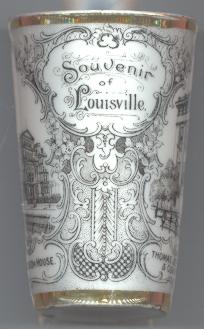
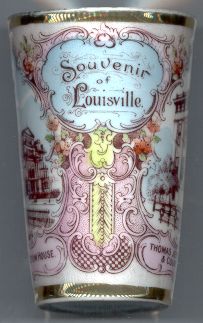 got the nickname “The Graveyard of the West”.
In 1828 Louisville was incorporated, being the first city in the Commonwealth with its own judicial and taxing authority. In 1839, it was the first western city to light its streets with gas lamps.
Although Kentucky initially was a neutral state in the Civil War, Kentucky declared itself a Union state in 1861. When the country grew westward after the war, it was found that the important trade routes
bypassed Louisville. The city therefore developed ambitions to become a manufacturing as well as a mercantile center. The city put on two large showcases of industry:
the Louisville Industrial Exposition in 1872 and the mammoth Southern Exposition in 1883. The 20th century began with a prosperous period; however, the Depression hit Louisville hard.
Since the years of World War the economy was rising steadily. Since the 1970s the economy changed with a decline of blu-collar employment and a rise in
service and financial-sector jobs.
got the nickname “The Graveyard of the West”.
In 1828 Louisville was incorporated, being the first city in the Commonwealth with its own judicial and taxing authority. In 1839, it was the first western city to light its streets with gas lamps.
Although Kentucky initially was a neutral state in the Civil War, Kentucky declared itself a Union state in 1861. When the country grew westward after the war, it was found that the important trade routes
bypassed Louisville. The city therefore developed ambitions to become a manufacturing as well as a mercantile center. The city put on two large showcases of industry:
the Louisville Industrial Exposition in 1872 and the mammoth Southern Exposition in 1883. The 20th century began with a prosperous period; however, the Depression hit Louisville hard.
Since the years of World War the economy was rising steadily. Since the 1970s the economy changed with a decline of blu-collar employment and a rise in
service and financial-sector jobs.
Zachary TAYLOR (1784–1850), 12th President (1849–1850) of the United States, spent his youth in Louisville.
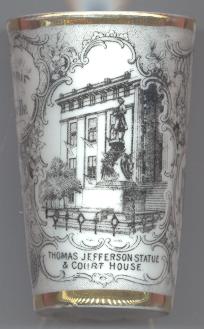
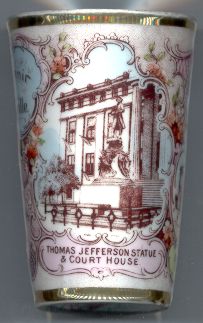
The  Jefferson County Court House [right, background] in Greek Revival style by the architect Gideon Shryock (1802–1880) was partially opened in 1842 and was completed in 1859.
It had been comissioned by the notable Louisville businessman and politician James Guthrie. It became known as „Guthrie's folly“ because he had hoped that it would
be used when Louisville would become the state capital of Kentucky. During the 1840's, both slave sales and abolition meetings took pace here, demonstrating Louisville's
border status at that time. In 1862, the court house indeed served as the capitol of Kentucky when the state's legislature was forced out of Frankfort by the Confederate army and took refuge here.
In front of the Court House you can see the statues of Thomas Jefferson and King Louis XVI of France.
The
Jefferson County Court House [right, background] in Greek Revival style by the architect Gideon Shryock (1802–1880) was partially opened in 1842 and was completed in 1859.
It had been comissioned by the notable Louisville businessman and politician James Guthrie. It became known as „Guthrie's folly“ because he had hoped that it would
be used when Louisville would become the state capital of Kentucky. During the 1840's, both slave sales and abolition meetings took pace here, demonstrating Louisville's
border status at that time. In 1862, the court house indeed served as the capitol of Kentucky when the state's legislature was forced out of Frankfort by the Confederate army and took refuge here.
In front of the Court House you can see the statues of Thomas Jefferson and King Louis XVI of France.
The  statue of Thomas Jefferson (1743–1826) [right, foreground], 3rd President (1801–1809) of the United States, was donated in 1901.
The statue of Louis XVI [not depicted on the tumbler], after whom Louisville is named, was sculptured in 1827 and was donated by the mayor of Montpellier, France, in 1967.
statue of Thomas Jefferson (1743–1826) [right, foreground], 3rd President (1801–1809) of the United States, was donated in 1901.
The statue of Louis XVI [not depicted on the tumbler], after whom Louisville is named, was sculptured in 1827 and was donated by the mayor of Montpellier, France, in 1967.
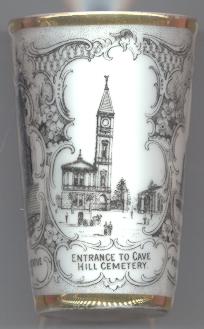
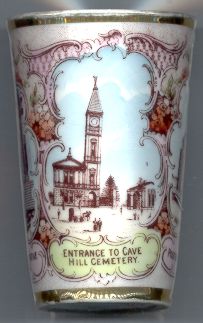
 Cave Hill Cemetary left] was created in 1848 and occupies an area of 296 acres. With its 5 lakes and more than
500 varieties of trees and shrubs it may be Louisville's most beautiful and peaceful place. More than 5000 Union soldiers and 200 Confederate soldiers from the Civil War are buried here,
and many notable Kentuckians have been laid to rest here, including James Guthrie and Gen. George Rogers Clark (1752–1818), founder of Louisville.
Cave Hill Cemetry was listed in the National Register of Historic Places in 1979.
Cave Hill Cemetary left] was created in 1848 and occupies an area of 296 acres. With its 5 lakes and more than
500 varieties of trees and shrubs it may be Louisville's most beautiful and peaceful place. More than 5000 Union soldiers and 200 Confederate soldiers from the Civil War are buried here,
and many notable Kentuckians have been laid to rest here, including James Guthrie and Gen. George Rogers Clark (1752–1818), founder of Louisville.
Cave Hill Cemetry was listed in the National Register of Historic Places in 1979.
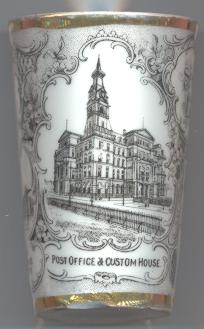
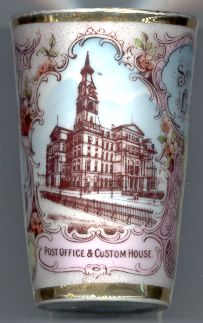
The  Post Office and Custom House [right] on the corner of Fourth and Chestnut Streets was built in 1892.
The building was demolished in 1942.
Post Office and Custom House [right] on the corner of Fourth and Chestnut Streets was built in 1892.
The building was demolished in 1942.
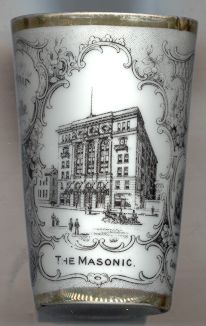
The  Masonic Temple on Chestnut between 3rd and 4th was built in 1902 by the architectural firm of
(William J.) Dodd & Cobb.
In its later days it housed the Masonic (Strand) Theater.
Like many other old buildings of Louisville, it was demolished in 1956 and the place was converted into a parking lot.
Masonic Temple on Chestnut between 3rd and 4th was built in 1902 by the architectural firm of
(William J.) Dodd & Cobb.
In its later days it housed the Masonic (Strand) Theater.
Like many other old buildings of Louisville, it was demolished in 1956 and the place was converted into a parking lot.
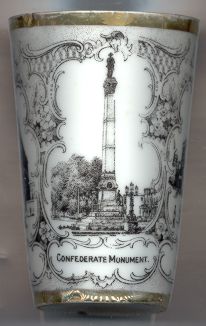
The  Confederate Monument at 3rd and Brandeis was erected in 1895 by the Kentucky Women's Confederate Monument Association
to honor the rank and file of Confederate soldiers who died during the Civil War. The monument cost $12,000.
Public opposition prevented its removal as
a traffic hazard in the 1920s and 1940s, though the original 48-foot diameter circle was reduced in size, and the lighting
removed in the 1950s. More recently, in the 1990s, the monument was called "politically
incorrect" and trees were planted near the base of the monument to somewhat obscure its
message.
Confederate Monument at 3rd and Brandeis was erected in 1895 by the Kentucky Women's Confederate Monument Association
to honor the rank and file of Confederate soldiers who died during the Civil War. The monument cost $12,000.
Public opposition prevented its removal as
a traffic hazard in the 1920s and 1940s, though the original 48-foot diameter circle was reduced in size, and the lighting
removed in the 1950s. More recently, in the 1990s, the monument was called "politically
incorrect" and trees were planted near the base of the monument to somewhat obscure its
message.
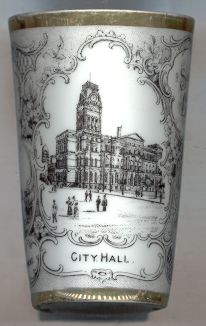
Three years after Louisville had passed the 100,000 mark for the first time in the 1870 census,
the grandiose new  City Hall
City Hall
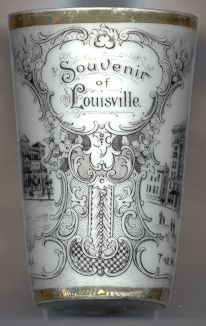
![[scale]](lineal.jpg)